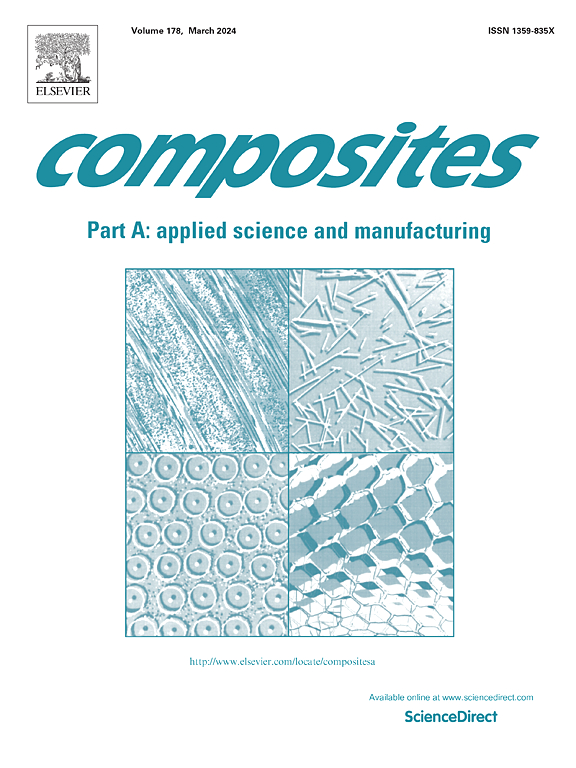A cutting force prediction model for UD-CFRP and MD-CFRP milling based on fracture mechanisms and mechanical properties
IF 8.1
2区 材料科学
Q1 ENGINEERING, MANUFACTURING
Composites Part A: Applied Science and Manufacturing
Pub Date : 2025-03-27
DOI:10.1016/j.compositesa.2025.108892
引用次数: 0
Abstract
Due to its exceptional properties, CFRP has become the material of choice for primary load-bearing structural components, such as composite fan blades, in aerospace and other industries. However, its anisotropy, heterogeneity, and unique characteristics make it a challenging material to machine. To address this issue, this paper presents a cutting force prediction model for CFRP milling based on the evolution of fracture mechanisms and material mechanical properties. The model introduces fracture coefficients, slip angle coefficients, and compression coefficients to accurately predict cutting force variations throughout the entire milling process, from tool entry to exit. The model was calibrated using orthogonal cutting experiments and single-angle slot milling experiments on UD-CFRP and further validated through slot milling experiments on UD-CFRP and two types of MD-CFRP, which were all conducted at various angles. Experimental results demonstrate that the proposed model can precisely predict cutting force variations during the entire milling process. Additionally, the model exhibits strong adaptability and scalability, compensating for the variability in CFRP material properties and enabling parameter adjustments for different engineering applications. It can also be applied to different laminate layups, ensuring broader applicability in composite manufacturing. Since the model is built upon fracture mechanisms and material properties, it provides an intuitive representation of the fracture evolution process during machining. The cutting force coefficients effectively characterize the fracture behavior in a straightforward manner. This model demonstrates great potential for machining composite fan blades, particularly in monitoring fracture mechanisms and predicting and controlling damage.
由于 CFRP 具有优异的性能,它已成为航空航天和其他行业主要承重结构部件(如复合材料风扇叶片)的首选材料。然而,其各向异性、异质性和独特性使其成为一种具有挑战性的加工材料。为解决这一问题,本文提出了一种基于断裂机制和材料机械性能演变的 CFRP 铣削切削力预测模型。该模型引入了断裂系数、滑移角系数和压缩系数,以准确预测从刀具进入到退出整个铣削过程中的切削力变化。利用 UD-CFRP 的正交切削实验和单角度槽铣实验对模型进行了校准,并通过 UD-CFRP 和两种 MD-CFRP 的槽铣实验(均以不同角度进行)进一步验证了该模型。实验结果表明,所提出的模型可以精确预测整个铣削过程中的切削力变化。此外,该模型还具有很强的适应性和可扩展性,可补偿 CFRP 材料特性的变化,并可针对不同的工程应用进行参数调整。该模型还可应用于不同的层压板铺设,确保在复合材料制造中具有更广泛的适用性。由于该模型建立在断裂机制和材料特性的基础上,因此可以直观地反映加工过程中的断裂演变过程。切削力系数以直观的方式有效地描述了断裂行为。该模型在加工复合材料风扇叶片方面,特别是在监测断裂机制以及预测和控制损伤方面,展现出了巨大的潜力。
本文章由计算机程序翻译,如有差异,请以英文原文为准。
求助全文
约1分钟内获得全文
求助全文
来源期刊

Composites Part A: Applied Science and Manufacturing
工程技术-材料科学:复合
CiteScore
15.20
自引率
5.70%
发文量
492
审稿时长
30 days
期刊介绍:
Composites Part A: Applied Science and Manufacturing is a comprehensive journal that publishes original research papers, review articles, case studies, short communications, and letters covering various aspects of composite materials science and technology. This includes fibrous and particulate reinforcements in polymeric, metallic, and ceramic matrices, as well as 'natural' composites like wood and biological materials. The journal addresses topics such as properties, design, and manufacture of reinforcing fibers and particles, novel architectures and concepts, multifunctional composites, advancements in fabrication and processing, manufacturing science, process modeling, experimental mechanics, microstructural characterization, interfaces, prediction and measurement of mechanical, physical, and chemical behavior, and performance in service. Additionally, articles on economic and commercial aspects, design, and case studies are welcomed. All submissions undergo rigorous peer review to ensure they contribute significantly and innovatively, maintaining high standards for content and presentation. The editorial team aims to expedite the review process for prompt publication.
 求助内容:
求助内容: 应助结果提醒方式:
应助结果提醒方式:


